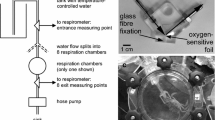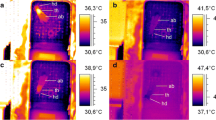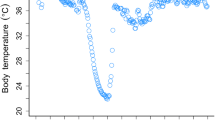Abstract
Respiration rates in the Antarctic amphipods Waldeckia obesa (Chevreux 1905) and Bovallia gigantea (Pfeffer 1888) were measured in relation to the presence or absence of a substratum to attach to, and the amount of time spent in a respirometer. During the first 4 h after placing animals in respirometers oxygen consumption in W. obesa was reduced by factors between 1.2 and 3.6 times by the presence of a nylon mesh net substratum. Oxygen consumption over the first 12 h after being placed in respirometers was reduced by factors of between 1.1 and 3.9 times for B. gigantea by the presence of pieces of corrugated plastic pipe. The effects on oxygen consumption of acclimating animals to respirometers were only assessed for W. obesa. Rates during the first 12 h after placing animals in chambers were 3.6 times higher than rates between 12 and 30 h after the start of trials. Standard metabolic rates were measured in W. obesa in the presence of a mesh substratum and following a 12 h acclimation period after 60 days of starvation. Under these conditions oxygen consumption was 2.5 μl O2 h−1 for a specimen of 0.113 g dry mass. This was 3–5 times lower than routine metabolic rates previously reported for W. obesa and 2.4–18 times lower than routine rates for other Antarctic gammaridean amphipods.
Similar content being viewed by others
References
Aarset AV, Torres JT (1989) Cold resistance and metabolic responses to salinity variations in the amphipod Eusirus antarcticus and the krill Euphausia superba. Polar Biol 9:491–497
Armitage KB (1962) Temperature and oxygen consumption of Orchomenella chilensis (Heller) (Amphipoda: Gammaroidea). Biol Bull Woods Hole Mass 123:225–232
Arnaud PM, Jazdzewski K, Presler P, Sicinski J (1986) Preliminary survey of benthic invertebrates collected by Polish Antarctic Expeditions in Admirality Bay (King George Island, South Shetland Islands, Antarctica). Pol Polar Res 7:7–24
Bayne BL, Bayne CJ, Carefoot TC, Thompson RJ (1976) The physiological ecology of Mytilus californianus Conrad. 1. Metabolism and energy balance. Oecologia 22:211–228
Bone DG (1972) Aspects of the biology of the Antarctic amphipod Bovallia gigantea Pfeffer at Signy Island, South Orkney Islands. Br Antarct Surv Bull 27:105–122
Bregazzi PK (1973) Locomotor activity rhythms in Tryphosella kergueleni (Miers) and Cheirimedon femoratus (Pfeffer) (Crustacea, Amphipoda). Br Antarct Surv Bull 33 & 34:17–32
Bulnheim H-P (1974) Respiratory metabolism of Idotea balthica (Crustacea, Isopoda) in relation to environmental variables, acclimation processes and moulting. Helgo Wiss Meeresunters 26:464–480
Bulnheim H-P (1979) Comparative studies on the physiological ecology of five euryhaline Gammarus species. Oecologia 44:80–86
Chapelle G, Peck LS, Clarke A (1994) Effects of feeding and starvation on the metabolic rate of the necrophagous Antarctic amphipod Waldeckia obesa (Chevreux, 1905). J Exp Mar Biol Ecol
Clarke A (1983) Life in cold water: The physiological ecology of polar marine ectotherms. Oceanogr Mar Biol Ann Rev 21:241–453
Clarke A (1988) Seasonality in the Antarctic marine environment. Comp Biochem Physiol 908:461–473
Clarke A (1991) What is cold adaptation and how should we measure it? Am Zool 31:81–92
Clarke A, Holmes LJ, White MG (1988) The annual cycle of temperature, chlorophyll and major nutrients at Signy Island, South Orkney Islands, 1969–1982. Br Antarct Suv Bull 80:65–86
Coleman CO (1991) Comparative fore-gut morphology of Antarctic Amphipod (Crustacea) adapted to different food sources. Hydrobiologia 223:1–9
De Broyer C (1983) Recherches sur la systématique et l'évolution des crustacés amphipodes gammarides antarctiques et subantarctiques. PhD Thesis, Université de Louvain, Louvain 468 pp
De Broyer C, Klages M (1990) Studies on amphipod biology. Polarforschung 68:113–115
De Broyer C, Jazdzewski K (1993) Contribution to the Marine Biodiversity Inventory: a checklist of the Amphipoda of the Southern Ocean. Doc Trav Inst R Sci Nat Belg 154pp
Dunbar MJ (1968) Ecological development in polar regions; a study in evolution. Prentice-Hall, Englewood Cliffs, NJ
Eastman JT (1993) Antarctic Fish Biology. Academic Press Inc, San Diego, 322 pp
Edwards RW, Learner MA (1960) Some factors affecting the oxygen consumption of Asellus. J Exp Biol 37:706–718
Everson I (1977) Antarctic marine secondary production and the phenomenon of cold adaptation. Philos Trans R Soc Lond 279:55–66
Fry FRJ (1958) Temperature compensation. Ann Rev Physiol 20:207–224
Gilbert NS (1991) Microphytobenthic seasonality in near-shore marine sediments at Signy Island, South Orkney Islands, Antarctica. Estuarine Coastal and Shelf Sci 33:89–104
Hiller-Adams P, Childress JJ (1983) Effects of feeding, feeding history and food deprivation on respiration and excretion rates of the bathypelagic mysid Gnathophausia ingens. Biol Bull 165:182–196
Holeton GF (1973) Respiration of arctic char (Salvelinus alpinus) from a high arctic lake. J Fish Res Board Can 30:717–723
Holeton GF (1974) Metabolic cold adaptation of polar fish: fact or artefact? Physiol Zool 47(3): 137–152
Ivleva IV (1973) Quantitative correlation of temperature and respiratory rate in poikilothermic animals. Pol Arch Hydrobiol 20:283–300
Jazdzewski K, De Broyer C, Teodorczyk W, Konopacka A (1992) Survey and distributional patterns of the amphipod fauna of Admiralty Bay, King George Island, South Shetland Islands. Pol Polar Res 12:461–472
Johnston IA, Battram JC (1993) Feeding energetics and metabolism in demersal fish species from Antarctic, temperate and tropical environments. Mar Biol 115:7–14
Johnston IA, Clarke A, Ward P (1991) Temperature and metabolic rate in sedentary fish from the Antarctic, North Sea and IndoWest Pacific Ocean. Mar Biol 109:191–195
Kangas P, Lappalainen A (1978) On the oxygen consumption of Mesidotea entomon (L.) (Crustacea, Isopoda). Kiel Meeresforsch 4:302–330
Klekowski RZ, Opalinski KW, Rakusa-Suszczewski S (1973) Respiration of Antarctic Amphipoda Paramoera walkeri Stebbing during the winter season. Pol Arch Hydrobiol 20:301–308
Lipski M (1987) Variations of physical conditions, nutrients and chlorophyll a contents in Admiralty Bay (King George Island, South Shetland Islands, Antarctica). Pol Polar Res 8:307–332
Lowry JK, Bullock S (1976) Catalogue of the marine gammaridean Amphipoda of the Southern Ocean. Bull R Soc NZ 16:1–187
Luxmoore RA (1984) A comparison of the respiration rate of some Antarctic isopods with species from lower latitude. Br Antarct Surv Bull 62:53–65
Maxwell JGH (1976) Aspects of the biology and ecology of selected Antarctic invertebrates. PhD Thesis, University of Aberdeen
Maxwell JGH, Ralph R (1985) Non-cold-adapted metabolism in the decapod Chorismus antarcticus and other sub-antarctic marine crustaceans. In: Siegfried WR, Condy PR, Laws RM (eds) Antarctic nutrient cycles and food webs. Springer, Berlin Heidelberg New York, pp 397–406
McWinnie MA (1964) Temperature responses and tissue respiration in Antarctic Crustacea with particular reference to the krill, Euphausia superba. Antarct Res Ser 1:63–72
Nagata K (1986) Amphipod crustaceans found near Syowa Station, Antarctica, Pt. 1. Mem Nat Inst Polar Res 40:249–258
Opalinski KW (1974) Standard, routine and active metabolism of the Antarctic amphipod Paramoera walkeri Stebbing. Pol Arch Hydrobiol 21:423–429
Opalinski KW (1982) Metabolic compensation in Amphipoda. Pol Arch Hydrobiol 29:367–373
Opalinski KW, Jazdzewski K (1978) Respiration of some Antarctic amphipods. Pol Arch Hydrobiol 25:643–655
Peck LS (1989) Temperature and basal metabolism in two Antarctic marine herbivores. J Exp Mar Biol Ecol 127:1–12
Peck LS, Uglow RF (1990) Two methods for the assessment of the oxygen content of small volumes of seawater. J Exp Mar Biol Ecol 141:53–62
Peck LS, Whitehouse MJ (1992) An improved desorber design for use in couloximetry. J Exp Mar Biol Ecol 163:163–167
Peck LS, Clarke A, Holmes LJ (1987) Summer metabolism and seasonal changes in biochemical composition of the Antarctic brachiopod Liothyrella uva (Broderip, 1833). J Exp Mar Biol Ecol 114:85–97
Presler P (1986) Necrophagous invertebrates of the Admiralty Bay of King George Island, (South Shetland Islands, Antarctica). Pol Polar Res 7:25–61
Rakusa-Suszczewski S (1982) The biology and metabolism of Orchomene plebs (Hurley 1965) (Amphipoda: Gammaridea) from McMurdo Sound, Ross Sea, Antarctica. Polar Biol 1:47–54
Rakusa-Suszczewski S (1990) Respiration of Orchomene plebs (Hurley 1965) and Waldeckia obesa (Chevreux 1905) from Admiralty Bay (South Shetland Islands, Antarctica). Pol Arch Hydrobiol 37:297–303
Rakusa-Suszczewski S, Klekowski RZ (1973) Biology and respiration of the Antarctic Amphipoda, (Paramoera walkeri Stebbing) in the summer. Pol Arch Hydrobiol 20:475–488
Rakusa-Suszczewski S, McWinnie MA (1976) Resistance to freezing by Antarctic fauna: supercooling and osmoregulation. Comp Biochem Physiol 54A:291–300
Ralph R, Maxwell JGH (1977a) The oxygen consumption of the Antarctic limpet Nacella (Patinigera) concinna. Br Antarct Surv Bull 45:19–23
Ralph R, Maxwell JGH (1977b) The oxygen consumption of the Antarctic lamellibranch Gaimardia trapesina trapesina in relation to cold adaptation in polar invertebrates. Br Antarct Surv Bull 45:41–46
Sainte-Marie B (1992) Foraging of scavenging deep-sea lysianassoid amphipods. In: Rowe GT, Pariente V (eds), Deep-sea food chains and the global carbon cycle. Kluwer, Dordrecht, pp 105–124
Saint-Paul U, Hubold G, Ekau W (1988) Acclimation effects on routine oxygen consumption of the Antarctic fish Pogonophryne scotti (Artedidraconidae). Polar Biol 9:125–128
Samp R (1980) Selected environmental factors in the waters of Admiralty Bay (King George Island, South Shetland Islands) December 1978–February 1979. Pol Polar Res 1(4):53–66
Scholander PF, Flagg W, Walters V, Irving L (1953) Climatic adaptation in arctic and tropical poikilotherms. Physiol Zool 26:67–69
Wells RMG (1986) Cutaneous oxygen uptake in the Antarctic icequab, Rhigophila dearborni (Pisces: Zoarcidae). Polar Biol 5:175–179
Wells RMG, Tetens V, De Vries AL (1984) Recovery from stress following capture and anaesthesia of Antarctic fish: haematology and blood chemistry. J Fish Biol 25:567–576
White MG (1975) Oxygen consumption and nitrogen excretion by the giant Antarctic isopod Glyptonotus antarcticus Eights in relation to cold-adapted metabolism in marine polar poikilotherms. In: Barnes H (ed) Proceedings of the Ninth European Marine Biology Symposium. Aberdeen University Press, Aberdeen, pp 707–724
Wohlschlag DE (1957) Differences in metabolic rates of migratory and resident freshwater forms of an arctic whitefish. Ecology 38:502–510
Wohlschlag DE (1960) Metabolism of an Antarctic fish and the phenomenon of cold adaptation. Ecology 41(2):287–292
Wohlschlag DE (1964) Respiratory metabolism and ecological characteristics of some fishes in McMurdo Sound, Antarctica. Antarct Res Ser 1:33–62
Author information
Authors and Affiliations
Rights and permissions
About this article
Cite this article
Chapelle, G., Peck, L.S. The influence of acclimation and substratum on the metabolism of the Antarctic amphipods Waldeckia obesa (Chevreux 1905) and Bovallia gigantea (Pfeffer 1888). Polar Biol 15, 225–232 (1995). https://doi.org/10.1007/BF00239063
Received:
Accepted:
Issue Date:
DOI: https://doi.org/10.1007/BF00239063




